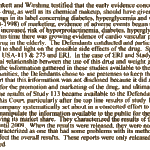These words are from David Foster Wallace. I don't know if he was speaking about the depression he had or the akathisia that antidepressants can cause. Maybe he didn't know and this contributed to his suicide. This post needs to be read in conjunction with What to do about Sex on RxISK. This post is about structural aspects to the problems not just of sexual dysfunction … [Read more...] about What to do about Suicide
AbbVie
Welcome to Troy
A lot people it seems have been singing and dancing in the street at news last week that AbbVie the pharmaceutical company that make Humira have dropped a legal action against the European Medicine’s Agency (EMA) that was aimed at blocking any access by researchers or others to their clinical trial data. Stacy of Arc Not everyone will be pleased though. Stacy London might … [Read more...] about Welcome to Troy
AbbVie & GSK Can Buy Your Data for Almost Nothing
Editorial Note: This prescient post written by Phil Booth was posted on OpenDemocracy.net under the title Your medical data - on sale for a pound on August 9th 2013. The original intention was to link it into the AbbVie debate about access to clinical trial data - as an ironic contrast. That opportunity passed - but a stopped clock throws up the right time twice a day. In … [Read more...] about AbbVie & GSK Can Buy Your Data for Almost Nothing
What Do Women Want?
Editorial Note: This is cross-posted from 1boringoldman - Reassure Us. It tackles the most important issue in healthcare and one of the most important in politics. GSK have clearly persuaded Ben Goldacre, Iain Chalmers and David Cameron, and J&J have persuaded Harlan Krumholz and Barack Obama that their model of Data Access - the AbbVie model - is the only game in town. See … [Read more...] about What Do Women Want?
EMA v AbbVie
Editorial Note: Three months ago we launched an AbbVie campaign and followed it up with a petition calling on AbbVie and InterMune to drop their action against EMA (European Medicines Agency). The hope was to raise awareness of this critically important issue that had been sailing beneath the radar. Over 6000 of you from more than 120 countries responded. This interim … [Read more...] about EMA v AbbVie
The Church of GSKology 2
A century ago Freud and Jung made us aware of the biases underpinning what patients say. Not everything should be accepted at face value. In particular claims of abuse may not be based on reality. We needed experts – analysts – they claimed to tease out what is real from what is not. The Catholic Church was once intensely hostile to Freud, but when it came to child abuse … [Read more...] about The Church of GSKology 2
The Church of GSKology
Editorial Note: This post is about midway through a series of posts that are broadly part of the AbbVie series. The series began with GSK's Transparency and Access Journey, moved on to The House of GSK and will have at least two more posts after this. Reading the Minneapolis StarTribune, it was the reference to privacy that clinched it. Facing a sexual abuse lawsuit, the … [Read more...] about The Church of GSKology
The House of GSK
In a just published article in the BMJ, Peter Doshi notes how in recent months the English pharmaceutical company GlaxoSmithKline (GSK) have assiduously portrayed themselves as advocates of transparency and in support of access to clinical trial data. Well in support of 'Responsible Access'. Responsible essentially means that a researcher commits to the primacy of RCTs and … [Read more...] about The House of GSK
Trade Wars we have known and loved: Brand EFPIA v Korea
Editorial note: a slight variation of this appeared last week on The Conversation. In 2010, the European Ombudsman ruled that the European Medicines Agency should open access to clinical trials data when companies applied to get their drugs on the market. The ombudsman decided public health was more important than considerations of commercial confidentiality. In February … [Read more...] about Trade Wars we have known and loved: Brand EFPIA v Korea
Health Action International: Access to Trial Data
Editorial Note: Leah Cowan and Ancel-la Santos from Health Action International wrote this post covering the release of a HAI position paper on Access to Clinical Trial Data. HAI have been to the forefront of the move to patient reporting of Adverse Events. It has a position as a partner with the European Consumer Organization (BEUC) in support of EMA in the current legal … [Read more...] about Health Action International: Access to Trial Data




